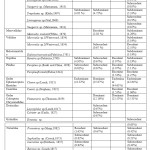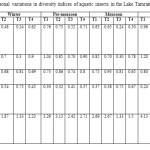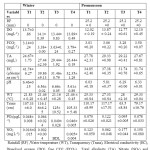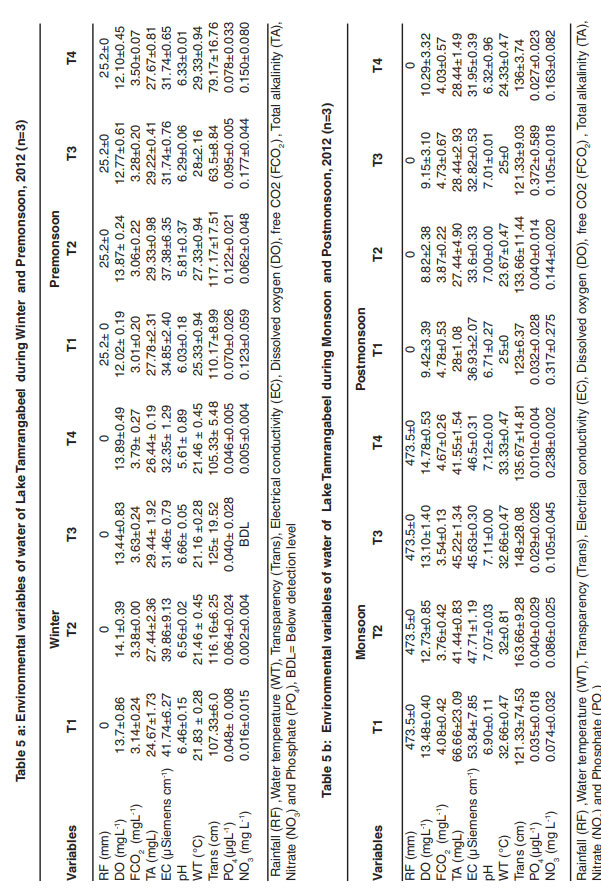Ecosystem Health of Lake Tamrangabeel, Bongaigaon District, Assam, India with Special Reference to Aquatic Insect Assemblage
R. R. Bhagawati1 and Susmita Gupta1
1
Department of Ecology and Environmental Science,
Assam University,
Silchar,
788011
Assam
India
DOI: http://dx.doi.org/10.12944/CWE.10.2.15
This study investigated the ecosystem health of a floodplain lake, Tamrangabeel of Bongaigaon district, Assam, India using aquatic insects as bioindicator. The aquatic community of Tamrangabeel was represented by 37 species belonging to 19 families and 5 orders. Shannon –Wiener diversity index (Shannon Hꞌ) values were recorded less than 1 in all the sites of the lake which indicated perturbed condition of the lake. Order Hemiptera was found to be the largest order with highest number of species. Eudominant species recorded in this lake were Micronecta siva (order Hemiptera) and Cloeon sp. (order Ephemeroptera). Biological Monitoring Working Party (BMWP) Score, Average Score per taxon (ASPT), and Stream Invertebrate Grade Number-Average Level (SIGNAL) Score reported from the study reflected good ecological potential as well as slightly impacted nature of the water body. The values of different environmental variables of water of all the sites of the lake were found conducive for aquatic life. This study provided an early warning of perturbation of the lake which is to be addressed before it is too late.
Copy the following to cite this article:
Bhagawati R. R, Gupta S. Ecosystem Health of Lake Tamrangabeel, Bongaigaon District, Assam, India with Special Reference to Aquatic Insect Assemblage. Curr World Environ 2015;10(2) DOI:http://dx.doi.org/10.12944/CWE.10.2.15
Copy the following to cite this URL:
Bhagawati R. R, Gupta S. Ecosystem Health of Lake Tamrangabeel, Bongaigaon District, Assam, India with Special Reference to Aquatic Insect Assemblage. Curr World Environ 2015;10(2). Available from: http://www.cwejournal.org/?p=12349
Download article (pdf)
Citation Manager
Publish History
Select type of program for download
| Endnote EndNote format (Mac & Win) | |
| Reference Manager Ris format (Win only) | |
| Procite Ris format (Win only) | |
| Medlars Format | |
| RefWorks Format RefWorks format (Mac & Win) | |
| BibTex Format BibTex format (Mac & Win) |
Article Publishing History
| Received: | 2015-07-02 |
|---|---|
| Accepted: | 2015-08-05 |
Introduction
Aquatic biodiversity is one of the most essential characteristics of the aquatic ecosystem for maintaining its stability and a means of coping with any environmental change.1,2 Aquatic insects comprise a taxonomically diverse and ecologically important group of animals. They are also known to play a very significant role in the processing and cycling of nutrients as they belong to several specialized feeding groups such as shredders, filter feeders, depositor collectors and predators.3 In recent times they are used as biological tool and also often used to determine the water quality based on type and number of species present, because pollution status of water bodies are expressed in biological and physico-chemical parameters.4 Data provided by indicator organisms can be used to estimate the degree of environmental impact and its potential dangers for other living organisms.5
Wetland ecosystems provide many services that contribute to human well-being. Together with energy and nutrients, water is arguably the centrepiece for the delivery of eco-system services to humankind.6 The Millennium Ecosystem Assessment7 defines ecosystems as a dynamic complex of plant, animal and microorganism communities and their nonliving environment interacting as a functional unit. The freshwater ecosystem services i.e nature’s works free of cost are particularly valuable to the inhabitants who are poor and entirely depend on nature’s services directly for their livelihoods.
Percentage of wetland area in India is 18.4%8 (IUCN, 1989); in Assam it is 9.74% and in Bongaigaon district of Assam it is 2.90 %.9 The district is very rich in wetlands (both permanent and seasonal) which are locally known as ‘beel’. Tamrangabeel, a floodplain lake is very rich in fish diversity, density and supports livelihood of fisherfolk community. Literature review revealed only one study on limnology, fish productivity and fish diversity of Tamrangabeel.10 No study on the fish food community like plankton and aquatic insects has been carried out till date. Further as a whole studies on aquatic insect community in north eastern region is meager although they are major food for insectivorous fishes and water fowls. In the above back drop this study aimed to investigate the ecosystem health of this important wetland and document the status of diversity and density of aquatic insects. An attempt will also be made to study the use of aquatic insects as bioindicator.
Materials and Methods
Tamrangabeel, a floodplain lake (latitude 26019ꞌ35ꞌꞌ and longitude 90034ꞌ43ꞌꞌ) is situated in the Bongaigaon district of Assam at about 200 km west of the state capital Guwahati and occupies a total area of 160.40 hectare. The lake is surrounded by a number of villages and very much in use for fishery purpose. The source of water of the lake is the excess water of River Brahmaputra. The connecting channel between Tamrangabeel and River Brahmaputra is known as Haripani.
Water samples and insects were collected from four sites (T1, T2, T3 and T4) of Tamranga beel in replicates seasonally viz., winter (December, 2012-February, 2013), pre-monsoon (March-May, 2013), monsoon (June-August, 2013) and post-monsoon (September-November, 2013) for a period of one year. Aquatic insects were collected by kick method whereby the vegetation was disturbed and a circular net (mesh size 60μm) was dragged around the vegetation for one minute.11,12 Three such drags constituted a sample. Collected insects were immediately sorted and preserved in 70% ethyl alcohol. They were later identified using a Motic stereozoom microscope using standard keys.13-20 Diversity indices were worked out by using package of Biodiversity Professional Version 2. Different biotic indices like Biological Monitoring Working Party (BMWP) Score, Average Score Per Taxon (ASPT), Stream Invertebrate Grade Number – Average Level (SIGNAL) were determined using the number and abundance of pollutant sensitive animals.21-24
Water temperature (WT), Transparency (Trans) pH, Electrical Conductivity (EC), Dissolved Oxygen (DO), Free CO2 (FCO2), Total Alkalinity (TA), Nitrate (NO3) and Phosphate (PO4) were estimated by standard methods.25,26 Meteorological data as rainfall (RF) data were obtained from Meteorological Station, Guwahati, Assam.
Results and Discussion
Macroinvertebrates have served as valuable indicators of degradation of aquatic ecosystem. As there is increasing pressure on our water resources, they should be used for assessing the impact of pollution in aquatic ecosystems.27 The aquatic community of Tamrangabeel was represented by 37 species belonging to 19 families and 5 orders (Table 1). Similar studies on a lake known as Koyakhujiabeel situated in the same district revealed occurrence of 37 species of aquatic insects.28 Several studies on aquatic insect diversity in different freshwater systems in North East India such as Loktak Lake, Manipur (Ramsar site); ponds of floodplain wetland of Cachar, Assam; one oxbow lake of south Assam ; another Ramsar site Deeporbeel, Guwahati, Assam; two temple ponds in Silchar, South Assam revealed occurrence of 7, 8, 9, 31 and 22 species of aquatic insects respectively.29-33 Compared to all these systems number of aquatic insect species in this lake is remarkable. This study reported 4 genera as new record in India. They are Trepobates sp. (family Gerridae), Plateumaris sp. (family Chrysomelidae) Pronoterus sp (family Noteridae) Suphisellus sp. (family Noteridae). Highest number of species was recorded in postmonsoon (Table 1).
 |
|
During Monsoon along with rainwater branches of trees, leaves, various macrophytes and other debris are deposited in the aquatic systems. During postmonsoon in low water level with the initiation of decomposition process the systems become rich in nutrients and conducive for aquatic insects for both food and shelter. In the present study Hemiptera was found to be the largest order in terms of species richness represented by 16 species and 7 families and highest number of species was recorded from the family Gerridae. In Du river basin in northern Vietnam also Hemiptera was found to be the most diverse order.34 A study carried out in the River Moirang, Manipur recorded highest relative abundance of order Hemiptera.35
According to the Engelmann Scale36 (1978) eudominant species recorded in this lake were Micronecta siva in winter and Cloeon sp. in winter and postmonsoon. Eudominance of Cloeon sp.was also recorded in one oxbow lake of south Assam31 and in one floodplain ecosystem of south Assam.37 The tolerance value play key role in using aquatic insects to monitor water41 and the tolerance value of Cloeon sp. is 4.24 Cloeon sp. belonging to the sensitive order, Ephemeroptera,38 is generally recorded in moderately polluted water.39 Another eudominant species recorded was Micronecta siva only in winter season.
Several biotic indices have been developed to assess water quality in the field.40 Diversity index can be used to measure environmental stress and high species diversity is an indication of fine distribution of resources among individuals of many species of a community.41 In the present study the Shannon –Wiener diversity index (Shannon Hꞌ) values were recorded less than 1 in all the sites of the lake which indicated perturbed condition of the water.42 (Table 2) The Biological Monitoring Working Party (BMWP) Score was computed by summing the individual scores of all families present in the system. High BMWP score indicates pollution intolerant families, while low scores mean pollution tolerant families.24 The Average Score per taxon (ASPT) is calculated by dividing the BMWP score by the total number of scoring taxa. In the present study, BMWP ranged from 9 to 51 across the sites and seasons. In most of the sites in most of the seasons water quality was interpreted as probable moderate pollution. Only once in post monsoon water quality was recorded good in site 1. According to ASPT Score also in the same season in the same site water quality was interpreted clean. ASPT Score ranged from 4.33 to 6.47 where except site 1 post monsoon all the scores were either in doubtful or in probable moderate pollution category. (Table 3) Again according to AWBS,43 an ASPT score greater or equal to the value of 4.5 indicate a good ecological potential of water body. SIGNAL (Stream Invertebrate Grade Number-Average Level) a scoring system for Macro-invertebrates23 was used to monitor the impact of disturbance. It is based on the known tolerances of aquatic macro-invertebrate families to various pollutants. Among all the seasons and all the sites, highest SIGNAL score (4.33) was found in T3 in monsoon indicating moderate pollution of water and rest were considered severely polluted44 (Table 4). However Chessman23 opined that in wetlands many sensitive groups like Plecoptera, Trichoptera are not found or rarely found. Therefore, wetlands are likely to have naturally lower scores than streams in the same region.
 |
Table 2: Seasonal variations in diversity indices of aquatic insects in the Lake Tamrangabeel Click here to View table |
Table 3: Seasonal variations in BMWP and ASPT Scores of different sites of Lake Tamrangabeel
|
BMWP |
||||||||
|
T1 |
|
T2 |
|
T3 |
|
T4 |
||
|
Winter, 2012 |
26 |
M |
19 |
PM |
9 |
P |
21 |
M |
|
Premonsoon, 2013 |
26 |
M |
14 |
P |
26 |
M |
32 |
M |
|
Monsoon,2013 |
26 |
M |
14 |
P |
9 |
P |
21 |
M |
|
Postmonsoon,2013 |
51 |
G |
44 |
M |
34 |
M |
19 |
M |
|
ASPT |
||||||||
|
Winter, 2012 |
5.2 |
D |
4.75 |
PMP |
4.5 |
PMP |
5.25 |
D |
|
Premonsoon, 2013 |
5.2 |
D |
4.67 |
PMP |
5.2 |
D |
5.33 |
D |
|
Monsoon,2013 |
4.33 |
PMP |
4.67 |
PMP |
4.5 |
PMP |
5.25 |
D |
|
Postmonsoon,2013 |
6.37 |
C |
5.5 |
D |
5.67 |
D |
4.75 |
PMP |
BMWP score: 0-16=Poor water quality, 17-50=Moderate water quality, 51-100=Good water quality; ASPT score: >6=
Clean water, 5-6= Doubtful quality, 4-5 = Probable moderate pollution, <4 = Probable severe pollution
Table 4: Seasonal variations in SIGNAL 2 Scores of the different sites of Lake Tamrangabeel
|
SIGNAL 2 score |
T1 |
|
T2 |
|
T3 |
|
T4 |
|
|
Winter, 2012 |
3.4 |
SP |
3.27 |
SP |
3.87 |
SP |
3.54 |
SP |
|
Premonsoon, 2013 |
2.85 |
SP |
3.36 |
SP |
3.83 |
SP |
3.31 |
SP |
|
Monsoon,2013 |
3.2 |
SP |
3.8 |
SP |
4.33 |
MP |
3.4 |
SP |
|
Postmonsoon,2013 |
2.94 |
SP |
3.08 |
SP |
3.03 |
SP |
2.68 |
SP |
Signal 2 scores: > 6= healthy habitat, 5-6= mild pollution, 4-5= moderate pollution, < 44. = severe pollution
It is very important to study the physic-chemical factors which influence the biological productivity of the water bodies. The ranges of values of different environmental variables of water such as DO (8.82 to 14.11 mgL-1), EC (31.46 to 53.8 µSiemenscm-1) , pH (5.81 to 7.07 ), FCO2(3.01 to 4.78 mgL-1), TA (24.67 to 66.66 mgL-1), PO43- ( 0.01to 0.12µg L-1 ) and NO3- (0.01 to 0.24 mgL-1) of all the sites of Lake Tamrangabeel in different seasons were found conducive for aquatic life (Table 5 a,b).
 |
Table 5(a): Environmental variables of water of Lake Tamrangabeel during Winter and Premonsoon, 2012 (n=3) Click here to View table |
 |
Table 5(b): Environmental variables of water of Lake Tamrangabeel during Monsoon and Postmonsoon, 2012 (n=3) Click here to view figure |
Conclusions
This is the first study on the ecosystem health of Lake Tamrangabeel of Bongaigaon district, Assam using aquatic insects as bioindicator. The number, composition and dominance status of aquatic insect species representing the lake; different biotic indices and scores; and the values of environmental variables tells about the ecological potential of the lake located in the Biodiversity hotspot Himalaya. At the same time this study provided an early warning of perturbation of the lake which is to be addressed before it is too late.
Acknowledgment
Authors are thankful to the Head, Dept. of Ecology and Environmental Science for providing laboratory facilities.
References
- Vinson, M. R. and Hawkins, C.P., Biodiversity of stream insects: variation at local, basin and regional spatial scales. Rev. Entomol., 43,271-293 (1998).
- Sharma, R.C.; Bhanot, G. and Singh, D., Aquatic macroinvertebrate diversity in Nanda Devi Biosphere Reserve, India. The Environmentalist, 24, 211-221(2004).
- Resh, V. and Rosenberg, D. The Ecology of aquatic insects. Praeger, New York. (1984).
- Lenat, D.R.; Smock, L.A. and Penrose, D.L.,Use of benthic macroinvertebrates as indicators of environmental effects. Douglass, L.W. (Ed.). Published by Lexington books. Toronto. 97 -114 (1980).
- Kovacs, M., Biological indicators in environmental protection. England: Ellis Horwood Limited (1992).
- Falkenmark, M. and Folke, C., Theme issue: Freshwater and welfare fragility: Syndromes, vulnerabilities and challenges, Royal Society’s Philosophical Transactions Biology, 358, 1440 (2003).
- MEA ( Millinneam Ecosystem Assessment), Ecosystems and human well-being Scenarios. Findings of the scenario working group island (2005).
- Directory of Asian Wetlands. IUCN Library System (1989).
- National Wetland Atlas, Assam, SEC/RESA/AFEG/NWIA/ATLAS/18/2010, Space ApplicationCentre ( ISRO), Ahmedabad, India (2010).
- Agarwal, N.K.,Limnology and fish productivity of Tamranga Wetland, Bongaigaon district of Assam (India) with special reference to some productivity indicator. Ph.D. Thesis, Gauhati University, India (1996).
- Brittain, J.E. ,Studies on the lentic Ephemeroptera and Plecoptera of Southern Norway.Norwegian Journal of Entomology, 21,135-151 (1974).
- Subramanian, K.A. and Sivaramakrishnan, K.G., Aquatic Insects of India-A Field Guide.Asoka Trust for Research in Ecology and Environment (ATREE), Bangalore, India. Small Grants Programme (2007).
- Wright, M. and Peterson, A., A key to the genera of Anisopterous dragonfly nymphs of the United States and Canada (Odonata, Suborder Anisoptera).Ohio Journal of Science, 44 (4),151- 166 (1944).
- Kumar, A. Descriptions of the last Instar Larvae of Odonata from the Dehra Dun Valley (India), with notes on biology І. (Suborder: Zygoptera). Oriental Insects, 7: 23-61 (1973 a).
- Kumar, A., Descriptions of the last instar larvae of Odonata from the Dehra Dun Valley (India), with notes on biology ІІ. (Suborder: Anisoptera). Oriental Insects, 7:291-331(1973 b).
- Pennak , R. W., Fresh-water invertebrates of the United States.2nd edition John.Wiley and Sons. New York. 803(1978).
- Bal, A. and Basu, R.C., Insecta: Hemiptera: Mesoveliidae, Hydrometridae, Veliidae and Gerridae. In: State Fauna Series 3: Fauna of West Bengal, Part 5. Zoological Survey of India, Calcutta, 511–534 (1994a).
- Bal, A.and Basu, R.C., Insecta: Hemiptera: Belostomatidae, Nepidae, Notonectidae and Pleidae, In: State fauna series 5: Fauna of West Bengal. Part 5.Zoological Survey of India, Calcutta, 535–558(1994b).
- Westfall, M. J. Jr. and Tennessen, K.J., Odonata, an introduction to the aquatic insects of North America, 3rd Ed. R.W Merrit and Cummins (eds) Kendell/ Hunt Publishing Company . Dubuque, Iowa, 164-211(1996).
- Thirumalai, G.A., Checklist of Gerromorpha (Hemiptera) from India. Records of Zoological Survey of India, 100(1-20): 55-97 (2002).
- Wright, J.F.; Moss, D.; Armitage, P.D. and Furse, M.T., A preliminary classification of running water sites in Great Britain based on macro- invertebrate species and the prediction of community type using environmental data. Freshwater Biology, 14: 221-56 (1984).
- Chessman, B. ,SIGNAL scoring system for bio-assessment by community groups. LWRRDC project NDW26 (2001).
- Chessman, B. SIGNAL-2 A Scoring System for Macroinvertebrate (‘Water Bugs’) in Australian Rivers, Monitoring River Health Initiative Technical Report no 31, Common wealth of Australia, Canberra (2003).
- Mandaville, S.M., Benthic macroinvertebrates in freshwater – taxa tolerance values, metrics and protocols, project H-1. Soil and Water Conservation Society of Metro Halifax, Halifax (2002).
- Michael P., Ecological Methods for field and laboratory investigation. Tata Mc. Graw-Hill publishing Company Ltd., New Delhi, 434 p.( 1984)
- P.H.A., Standard methods for examination of water and wastewater. 21st Edn. APHA, AWWA, WPCF Publications, Washington DC, USA (2005).
- Wallace J.B. and Webster J.R., The role of macro-invertebrates in stream ecosystem function. Rev. Entomol., 41, 115–139 (1996).
- Bhagawati, R. R. and Gupta, S., Aquatic Insect diversity of Koyakujiabeel, a floodplain lake of Bongaigaon district, Assam, India, Ne BIO., 5, 5, (2014).
- Takhelmayum, K. and Gupta, S., Distribution of aquatic insects in phumdis (floating island) of Loktak lake, Manipur, Northeastern India. JoTT, 3(6),1856-1861(2011).
- Purkayastha, P. and Gupta, S., Insect diversity and water quality of parameters of two ponds of Chatla wetland, Barak Valley, Assam. CWE, 7(2),243-250 (2012).
- Gupta , S. and Narzary, R., Aquatic insect community of Lake, Phulbari anua in Cachar, Assam. JEB, 34 (3), 591-597 (2013).
- Choudury, D and Gupta , S. , Aquatic insect community of Deepor beel (Ramsar site), Assam, India JEZS, 3 (1), 182-192 (2015)
- Dalal, A. and Gupta, S., Aquatic insect diversity in two temple ponds of Silchar, Assam, N.E. India and their conservation value, KMAE, 415, 09 (2014)
- Hoang, T.H.; Lock, K.; Chi Dang, K.; De Pauw, N and Gooethals, P.L.M., Spatial and temporal patterns of macroinvertebrate communities in Du River Basin in Northern Vietnam. J. Freshwat. Ecol., 25:637-647 (2010).
- Takhelmayum, K.; Gupta, S. and Singh, N.R., Diversity and density of aquatic insects in the lower reach of River Moirang, Manipur, North East India. Natl. Acad. Sci., India, Section B: Biological Sciences, 83(4),575-584 (2013).
- Engelmann, H. D. Zur Dominanzklassifikazierung von Bodenart hropoden. Pedobilogia, 18, 378-380 (1978).
- Purkayastha, P. and Gupta, S., Ecology of Monabeel, a floodplain ecosystem of Cachar, Assam with special reference to aquatic insect community. Trop. Ecol., 56(2), 245-255 (2015).
- Rosenberg D. M. and Resh V., Freshwater biomonitoring and benthic macroinvertebrates. Chapman & Hall, New York-London. 486 p. (1993).
- Alba-Tercedor, J.; Zamora-Munoz, C.; Sanchez-Ortega, A. and Guisasola , I., Mayflies and stoneflies from the RioMonachil (Sierra, Nevada Spain) (Ephemeroptera and Plecoptera). In: Overview and strategies of Ephemeroptera and Plecoptera . (Eds: J. Alba-Tercedor and A.Sanchez Ortega) Gainesville: Sandhill crane press, Inc. 529-538. (1991).
- Washington, H.G., Diversity, biotic and similarity indices: a review with special relevance to aquatic ecosystems. Water Res. 18:653-694 (1984).
- Mason, C.F., Biological aspects of freshwater pollution. In: Harrison, R.M. (Ed.),Pollution: Causes, Effects, and Control. Royal Society of Chemistry, Cambridge:United Kingdom, pp. 99–125 (1990).
- Turkmen, G. and Kazanci, N., Applications of various biodiversity indices to benthic macroinvertebrate assemblages in streams of a national park in Turkey.Rev. Hydrobiol, 3,11-125 (2010).
- W.B.S., Interim report on ecological classification for Ireland’s AWBs 2.The Surface Water Status Group, Ireland (2008).
- Gooderham, J. and Tsyrlin, E., The Waterbug Book: A Guide to the freshwater macroinvertebrates of temparete Australia. Collingwood VIC 3066, Australia: CSIRO Publishing (2002).






